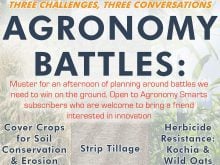Harvest may be a few weeks away, but the Saskatchewan Agricultural Hall of Fame is set to present a bumper crop of inductees on July 31 in Saskatoon.
The hall of fame recognizes individuals who have made a considerable contribution to agriculture and rural living.
But as one inductee noted, it’s about more than a plaque on the wall.
“While the hall of fame is an entity, it’s really more of a spirit that signifies the contributions that people have made over the past 100 years to agriculture,” said Glen Hass.
Read Also

VIDEO: Agritechnica Day 4: Robots and more robots, Nexat loves Canada and the trouble with tariffs
Agritechnica Day 4: Robots and more robots, Nexat loves Canada and the trouble with tariffs.
Most years fewer than six women and men are inducted into the hall of fame, but the calibre of candidates this year prompted the selection committee to choose six.
Carl Block (deceased) was an effective diplomat on behalf of cattle producers and the beef industry.
He operated a 900-head cow-calf and backgrounding operation near Abbey and served as president of the Saskatchewan Stock Growers Association in 1995-96.
Developing a strong, profitable Canadian cattle industry and keeping it healthy was important to Block. To that end, as chair of the Canadian Animal Health Coalition, he led a delegation to the United Kingdom and the Netherlands to learn from their experiences with foot-and-mouth disease.
Abigail Delury (deceased) is credited with increasing the base and effectiveness of women’s organizations in Saskatchewan. Born in 1872, she trained and taught in Ontario and Quebec before relocating to Moose Jaw to teach home economics in the public school system.
The University of Saskatchewan Extension Division hired her for the summers of 1911 and 1912 to visit rural fairs and to urge women to form homemakers’ clubs.
She was so successful at this that she was appointed the first Director of Women’s Work at the U of S in 1913 and tripled the number of homemakers’ clubs in her 17-year tenure.
Glen Hass has contributed to the agricultural fabric of the province through soil conservation, agricultural extension and 4-H leadership. He joined the U of S extension staff in 1969 as supervisor of 4-H and was elected president of the Canadian 4-H Council in 1977.
Hass became the executive director of Soil Conservation Canada in 1995, but before that was active in organizing the Saskatchewan Soil Conservation Association. He describes this as his proudest achievement.
“One of the things that totally amazed me was how quickly farmers adapted to something that was entirely different. I don’t think ever in the history of agriculture in Saskatchewan has there been anything that changed and grew so rapidly as the practices in soil conservation.”
Hass also served as the executive director of the Saskatchewan Institute of Agrologists from 1993-2004.
Neil Jahnke is a leader and champion of Canada’s livestock industry who runs a ranch with his family near Gouldtown. He has been involved with the Saskatchewan Stock Growers Association for more than 40 years and served one term as president of both the SSGA and the Canadian Cattlemen’s Association.
Jahnke has been active with increasing beef exports to the Pacific Rim and the Far East, and he defended the Canadian cattle industry against R-CALF antidumping allegations. He has been a director of Canadian Western Agribition for many years and was instrumental in establishing the commercial cattle show at Agribition.
When asked about milestones in his career, Jahnke said he likes achievements that can be measured. He said his involvement with the Canada Beef Export Federation was especially rewarding, because the federation could see from year to year that export sales had increased.
As well, Jahnke is proud of having helped the CCA get boneless boxed beef shipped to the United States three months after the border closed due to BSE.
“I think a lot of people have forgotten what our industry would look like if that beef had not started moving to the U.S. in September of 2003,” he said.
When asked about the future of the beef industry in Canada noting the BSE crisis, Jahnke was positive, given the recent opening of the U.S. border.
“Obviously the administration down there wants the beef, and most of the (U.S.) industry realizes that to save their industry they’re going to need some of our cattle,” Jahnke said. “I’m always optimistic.”
Henry Martynse (deceased) was a registered seed grower, an authority on grain farming and a large community supporter. Early in his career, he became regarded as an authority on seed production, developing new seed varieties, cleaning grain and weed control and encouraging other farmers to become seed growers by example. He also wrote a column in Grainews.
Martynse won the world pedigreed seed championship in 1973 and was president of the Saskatchewan Seed Growers in 1980-81 and the Canadian Seed Growers Association 1989-91.
John Willmott is a dedicated promoter of the cattle industry and was a leader in bringing the Angus breed back to popularity in the last decade.
“I like to think that I perhaps made Angus cattle and the beef business better for what I’ve done,” Wilmott said.
He served as president of Canadian Western Agribition in 1978-79 and chair of the Western Canada Farm Progress Show in 1981-82.
Willmott was president of the Saskatchewan Livestock Association and a member of the Beef Breeds Board in 2000-01, urging commercial and purebred cattle producers from all breeds to work together to ensure a healthy beef industry. He showed cattle throughout Canada and judged shows in Canada, the U.S. and Australia.
Willmott was a 4-H leader for 21 years and said that the youth organization has always been quite close to him, because he met his wife through the program. More recently he has brought a farmer perspective to the Canadian Federation of Humane Societies, serving as a director.
The hall of fame has inducted 180 members since its inception in 1972.
“It’s always nice when you’re honoured by your peers, but there are probably other people out there who are more deserving than me,” Willmott said, a sentiment echoed by other inductees.
“When you get into something like agriculture, you hope to leave it better than when you came in. It’s up to history to tell you if you have, in the long run.”
To nominate a candidate, write the SAHF, 2610 Lorne Avenue, Saskatoon, Sask., S7J 0S6. The deadline for 2006 nominations is Sept. 1, 2005.














